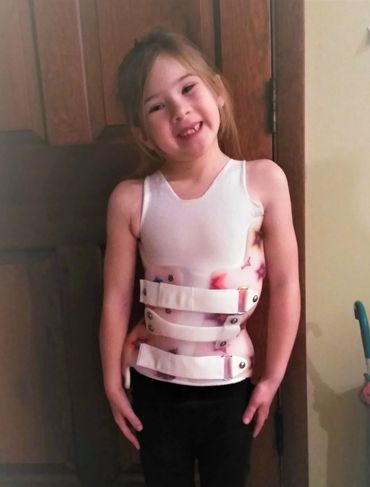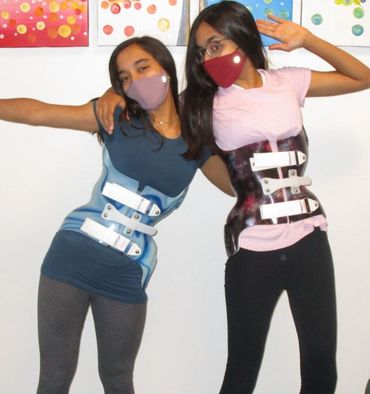Experts in scoliosis bracing.

CHICAGO PEDIATRIC ORTHOTICS SCOLIOSIS
We’re excited to announce that we now offer custom scoliosis braces for adults, in addition to our existing services for children. Our physician and therapist colleagues expressed the need for custom scoliosis bracing for adults. Our adult scoliosis braces are designed with both comfort and effectiveness in mind, tailored to meet the unique needs of each individual. Whether you're managing chronic pain, postural changes, or seeking non-surgical support, our team is here to help you find the right solution. With advanced materials and personalized fittings, we’re committed to providing high-quality spinal care for all ages.
Chicago Pediatric Orthotics is proud to be recognized as a Scoliosis Center of Excellence. We have successfully treated thousands of children and teens with scoliosis, achieving curve corrections of up to 100% with our custom-designed scoliosis braces. Many of our patients have seen significant improvements in their spinal curves by following their prescribed bracing schedules and incorporating targeted exercises.
Our scoliosis bracing program is highly effective at reducing the need for surgical intervention while also helping to prevent long-term back pain. With consistent use of our spinal orthoses and adherence to treatment recommendations, we aim to provide patients with improved spinal alignment and better overall outcomes.
To ensure optimal results, we utilize advanced computer-aided design (CAD) technology to create braces that precisely correct scoliosis curves. Regardless of the type of brace your orthopedic surgeon recommends, we can provide it—whether it’s 3D asymmetric, GOSS, Cheneau-style, Lyon, Providence, Wilmington, Milwaukee, Boston, one-piece, bivalve, or others. Our team is dedicated to designing the best brace to effectively treat your child’s scoliosis.
Scoliosis bracing Idiopathic scoliosis Braces for scoliosis Chicago Scoliosis Bracing Experts in Scoliosis Scoliosis back brace Scoliosis of the spine
Best Scoliosis Brace Scoliosis Treatment Chicago, Skokie, Evanston, Wilmette, Glenview, Northbrook, Lake Forest, Palatine, Niles, Park Ridge, Morton Grove, Arlington Heights
Why Starting Scoliosis Bracing Before Puberty is Crucial
Scoliosis, a condition characterized by an abnormal 3-dimentional curvature of the spine, affects millions of children worldwide. While the severity of scoliosis varies, early intervention significantly impacts the long-term outcomes for children with this condition. One of the most effective non-surgical treatments is bracing, particularly when initiated before puberty. It is important to begin scoliosis bracing early—prior to the adolescent growth spurt—is essential.
Understanding Scoliosis Progression
Scoliosis typically develops during childhood and adolescence, with the majority of cases being idiopathic (of unknown cause). A key factor in the progression of scoliosis is growth. The spine’s curvature often worsens during periods of rapid skeletal growth, such as puberty. By the time a child enters their adolescent growth spurt, untreated scoliosis can advance quickly, making correction or stabilization more challenging.
The Role of Bracing
Bracing aims to prevent the progression of spinal curvature in growing children. Modern scoliosis braces are custom-designed to fit each child’s unique anatomy and provide corrective pressure to the spine while allowing room for growth. Braces are most effective when used early in the condition’s progression, particularly when the curve is moderate (20-35 degrees) and the child is still skeletally immature.
Why Pre-Puberty Intervention Matters
- Maximizing Growth Potential: Beginning bracing before puberty takes advantage of the child’s remaining growth potential. This allows the brace to guide the spine as it grows, reducing the likelihood of significant curve progression.
- Preventing Severe Deformities: Severe scoliosis (curves greater than 50 degrees) often requires surgical correction, which carries inherent risks and a lengthy recovery period. Early bracing can prevent the condition from reaching this critical threshold.
- Improved Compliance: Younger children are often more adaptable to wearing a brace compared to teenagers. Starting treatment early establishes a routine, increasing the likelihood of consistent brace use and better outcomes.
- Reducing Long-Term Health Risks: Progressive scoliosis can lead to complications such as chronic back pain, reduced lung function, and impaired quality of life. Early intervention minimizes these risks, promoting better overall health into adulthood.
The Science Behind Early Bracing
Research consistently supports the efficacy of early bracing. Studies published in leading medical journals show that children who begin bracing before puberty have a significantly lower risk of curve progression compared to those who start treatment later. Moreover, advancements in brace technology—such as lightweight, low-profile designs—have improved both comfort and effectiveness, making early intervention more practical for children and their families.
Overcoming Barriers to Early Bracing
Despite its benefits, early bracing is sometimes delayed due to a lack of awareness or misconceptions about scoliosis treatment. Parents and healthcare providers must work together to:
- Ensure Early Detection: Routine screening, especially during well-child visits, is crucial for identifying scoliosis in its early stages.
- Educate Families: Providing clear information about the benefits of early bracing can help families make informed decisions.
- Address Emotional Concerns: Wearing a brace can be daunting for children. Support groups and counseling can help them adjust to treatment and feel empowered.
Conclusion
Scoliosis bracing is a proven, non-invasive treatment that can dramatically improve outcomes when initiated early. Starting before puberty allows for optimal use of the child’s growth potential to correct and stabilize the spine. By prioritizing early detection and intervention, parents and healthcare providers can help children with scoliosis lead healthier, more active lives.
If you suspect your child may have scoliosis, don’t wait. Schedule a screening with your pediatrician or orthopedic specialist today. Early action can make all the difference.
Our goal is to improve your child's scoliosis curves

Out of brace vs in-brace x-ray
Out of brace vs in-brace x-ray
Out of brace vs in-brace x-ray
Our goal is to correct the spinal curves as much as possible while wearing the custom spinal brace. This is an example of curve correction while wearing a custom scoliosis brace from Chicago Pediatric Orthotics. The left x-ray is while wearing the TLSO and the right is without. Near 100% correction is noted.

Successful treatment
Out of brace vs in-brace x-ray
Out of brace vs in-brace x-ray
Traditional practices define brace success as having the curves not get worse. Our goal, and clinical observation, is that significant improvements will be seen with brace compliance, younger age when starting brace treatment, scoliosis specific exercise program, and participation in regular physical activities, sports or dance.

Improved curves
Out of brace vs in-brace x-ray
Improved curves
With adherence to our brace treatment guidelines we anticipate some correction of the spinal curves.
The left picture is before treatment. The right is after 2 years of brace treatment.
Scoliosis bracing

Click link the link below to view some color options for your scoliosis brace.
Higgy CON 2024 was held in Rosemont IL. It was an amazing event for kids who have scoliosis!
Olivia SHares her story -

Hi! My name is Olivia and I'm 10 years old. I have a condition called scoliosis, it's where your spine isn't as straight as everyone else's. My curve is around 20 degrees on bottom and top. I was devastated when I found out I had it, because I thought I would have to have surgery. But, my curve wasn't as bad. My doctor found my scoliosis at my 9 year old check-up. Now, I'm 10 and on my second brace. A back brace isn't bad but isn't pleasant. When you first get your brace, the first few nights can be very hard to sleep. My mom had to come and lay down with me so I actually could fall asleep. But, after a few weeks with my brace I got used to it. I can sleep better because my mom bought me this special mattress that feels like memory foam. The hard part about my brace is that I play softball. This is hard because I get less time in my brace. So, I have to make up by wearing it all day. I laugh sometimes because I remember how hard it was when I first got it. For example, going to the bathroom, sitting down, car rides, etc. It will be hard sometimes but everything gets better. So to the girls that first get their brace, just remember, you're bent not broken.
XOXO,
Olivia F
A note from Pat Rogel, Olivia's orthotist: Olivia uses her time out of the brace to stay active. This is very important for all people with scoliosis. She is nearly perfect with her compliance, as well. This combination is the best hope for successfully preventing scoliosis from worsening and needing surgery. She is now 13 and her scoliosis has improved over the years.
Photo Gallery

Fabrication of a custom spinal brace most often utilizes computer aided design. After we take measurements and a 3-D scan, the brace is custom made for your spine. It is then carved using CAM.


Photo Gallery








Spinal stress injuries
ETHAN 17 yo level 10 gymnast
High level athletes endure huge amounts of dynamic stress that is often absorbed in the spine. After over 10 years of participating in high level men's gymnastics Ethan sustained a L5 Spondylolysis.
Spondylolysis is a breaking down (dissolution) of a portion of a vertebra called the pars interarticularis, which can separate. Spondylolysis can be a cause of abnormal movement of the spine (spondylolisthesis) and lead to long term back pain.
Treatment for spondylolysis is a custom brace.
Ethan wore his brace for 2-3 months until his spine healed completely.
Does scoliosis bracing work? Read the Braist study to get the details.
This website uses cookies.
We use cookies to analyze website traffic and optimize your website experience. By accepting our use of cookies, your data will be aggregated with all other user data.